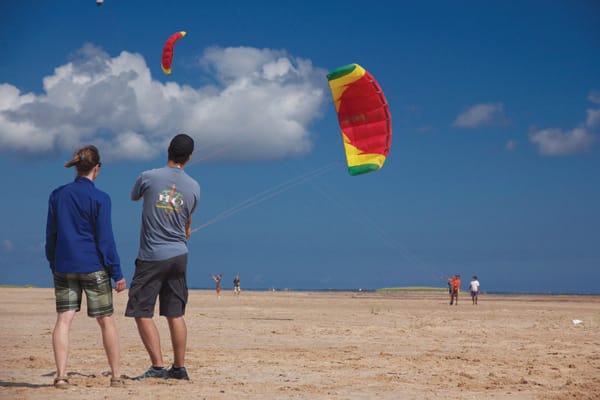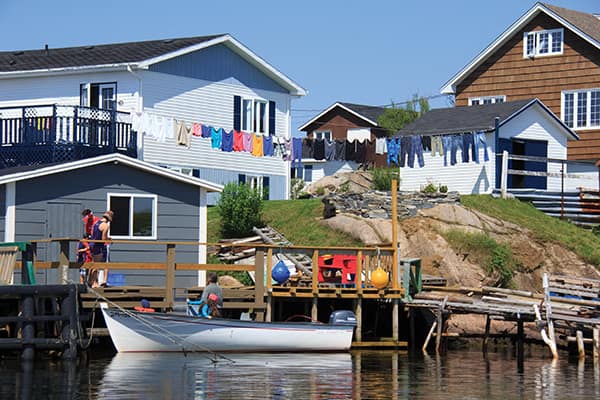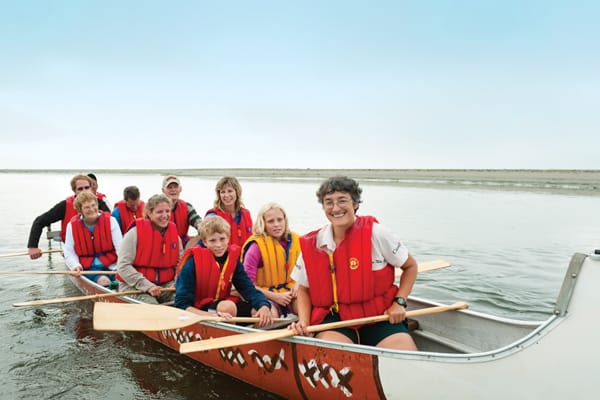A family vacation to Quebec’s Îles de la Madeleine offers more than one opportunity to take to the air.
Spectra string is non-elastic and bulletproof. The power line is red; the brake line is yellow. And don’t steer your kite like a car, as if turning a wheel—steer by pulling, like you’re doing karate or tae kwon do. “Now,” continues instructor Steve Mantha, slicing an imaginary quarter sphere through the air with his index finger, “pay attention to the wind window.” Higher up, he says, tilting his gaze to the top of our invisible chalkboard, there is less wind. Lower: more wind. Watch out. It can pull you off your feet.
And then Mantha, who works for Aérosport Carrefour d’Aventures, Canada’s first and biggest kiting school, hands me a pair of double-barrelled control bars, whose lines are stretched taut by an already airborne 3.5-square-metre kite made of ripstop nylon. The wind today is a calm 17 kilometres an hour—ideal for a rookie—yet the kite instantly rips me into a forward lurch. Mantha is teaching our small group the art of kite control, the first stage of kite-surfing, on Martinique Beach, on the east coast of Quebec’s Îles de la Madeleine (also known as the Magdalen Islands), and I’m just starting to understand the power of the wind.

After spending our last three summer holidays in Prince Edward Island, my wife, Lisa, and I wanted to explore a little farther east this year. We had watched the ferry come and go from our campground near Souris, PEI, and wondered about this isolated archipelago in the middle of the Gulf of St. Lawrence. On a map, Îles de la Madeleine resembles a pinched paperclip: thin sandspits encircling a succession of central lagoons, an endless horizon of sea in every direction, and a half-dozen hunks of higher ground for shelter when it storms. The islands are only 65 kilometres from tip to tip, yet they have more than 300 kilometres of saltwater beaches. Plus, it’s a long boat ride from where my in-laws are in PEI—reason enough to book passage.
There’s also, naturally, sea life (to watch) and seafood (to eat); a herring fumoir (smokehouse), a fromagerie, a microbrasserie! And should the need for translators arise here in “Quebec’s Caribbean” (for instance, to help us avoid a faux pas at the fromagerie), our daughters Maggie and Daisy were there to bail us out with their Grade 1 French-immersion chops.
But on the white sand of Martinique Beach, on a blue-sky afternoon in early August, the girls are leaping and yelping with Lisa in waist-high waves a few feet away. So when Mantha’s lesson slips into French, I strain my brain to follow. He’s talking about kite-surfing, about the freedom he feels while playing in the wind. “Le seul problème,” says Mantha, pausing—which prompts me to lean closer to listen—“C’est addictif.”
We arrive on a Friday evening ferry from Souris, a smooth five-hour sailing complete with a one-man-band performing Acadian pop songs in the lounge and several poutine combinations in the cafeteria. Just before pulling into port, Maggie gets stuck in a washroom stall and Lisa and I panic upon realizing we don’t know how to ask for help. Daisy suggests, “Ma soeur ne peut pas sortir la toilette.” We manage to extricate Maggie without assistance and, with newfound confidence, locate our van all by ourselves on the auto deck.
Exiting the ferry terminal onto rue Principale in Cap-aux-Meules, the largest village on the islands, every restaurant and bar patio we drive past is packed. It’s the final weekend of the annual Festival Acadien, which celebrates that spirited amalgam of Maritime and Quebecois joie de vivre, and since most of the 13,000 Madelinots have Acadian roots, the main street feels like a homecoming party. But it’s also peak season for a tourism industry that draws more than 50,000 visitors every year, about 85 per cent of them from Quebec. And judging by the bicycles, surfboards and kayaks hanging off nearly every vehicle in the convoy that pours out of the ferry, people come here to take pleasure in many ways.
While setting up our tent in Parc de Gros-Cap, a peninsula that juts out into Baie de Plaisance, a constant breeze keeps the bugs at bay. The cliff-side campground’s bohemian vibe hits us immediately. A very content looking grey-haired man strums an acoustic guitar outside his pop-top van in the next site (Eric Clapton’s “Tears in Heaven,” not “Blowin’ in the Wind”). Nearby, a group of 20-somethings staying at the hostel toss around a Frisbee. And from one of the picnic shelters, windborne drumming drifts into a sunset bouquet of campfire smoke.
The next morning, we walk to one of the park’s two beaches for our family’s maiden sea-kayaking excursion. As our guide explains how the rudder and foot pedals operate, Lisa and the girls pay particularly close attention to dark-haired and handsome Guillaume D’Amours (yes, that’s his real name). Turns out his charming pedagogy is well-practiced: D’Amours is a moonlighting high school outdoor sports teacher from Quebec City who first came to Îles de la Madeleine in 2007. “It was the best summer of my life,” he says.
The east side of the archipelago is too windy for beginners today, so we drive the width of Cap aux Meules Island to the harbour at L’Étang-du-Nord. It takes five minutes to reach the opposite shore. D’Amours helps us don water-tight skirts and PFDs, and we push off from the beach in tandem kayaks. The water inside the breakwater is flat, a little boring. But as we slip past a fishing boat and out of the harbour, even slight swells remind me that my previous paddling experience consists largely of canoeing on mirror-still lakes.
D’Amours leads us toward a small rocky outcrop called Îles aux Goélands—Gull Island. One can spot 200 bird species on Îles de la Madeleine, but if you look up while kayaking beneath a bird, D’Amours warns, it’s best to keep your mouth closed. He also cautions us about climate change. In the 1960s, the islands had about 90 days of ice every winter; now it’s 50 to 60 days—with no ice for the past two winters. And without ice to protect the coastline from waves whipped up by winter winds, the archipelago is losing an annual average of 80 centimetres to erosion. One spot on tiny Île de la Pointe aux Loups is losing six metres every year.
On Martinique Beach the following afternoon, Steve Mantha gives us that introduction to kite control. The kite we’re piloting is too powerful for the girls, so Lisa and I take turns. She’s better than me—like the wind here, another constant. My lurching and crashing continues. But eventually, as Mantha had coached, I start to anticipate the movement and learn how to maneuver the kite into a nose dive and practically kiss the ground before pulling it back to the sky.
Our lesson ends with a round of rides in a tandem buggy that Mantha drives along the beach. Propelled by a chest-harness-mounted kite and steered with your feet, a buggy like this can reach 70 kilometres an hour. On the water, he tells me, kite-surfers can leap nearly 10 metres into the air and fly 30 metres before landing. But that, he says, kicking up a spray of sand with a sharp turn, takes practice.
“Kite-surfing is about freedom,” says Mantha, who was an elevator mechanic and discovered the sport when he came to Îles de la Madeleine for a holiday. Now he teaches it around the world. “On the water, you can go anywhere. I play with the elements when I’m out there, I play with the wind.”
“Is kite-surfing as much an art as a sport” I ask Mantha.
“No,” he responds, puzzled. “It’s a sport. An extreme sport.”
Which makes me suspect that maybe I’ve been romanticizing the wind too much. Especially when, back at Parc de Gros-Cap that evening, a storm blows in.
The rain is still light when the girls fall asleep, but it’s a downpour by the time Lisa and I go to bed. Water pools atop our tent’s fly and drips through a seam onto Daisy, so around midnight we venture out into what has become a gale and attempt to tie down an extra tarp. The oversized sheet of blue plastic whips around wildly, but we succeed—sort of. We remain dry, although the tarp’s flapping, just a few inches from my face, keeps us awake all night.
The storm is just as strong the next morning, so we retreat to a picnic shelter for cereal and campstove cappuccino. Let it rain. It’s our final day on the islands and we’ll take the girls to the indoor aquarium. That fromagerie, herring smokehouse and microbrewery are also calling.
But first we must take down our tent. Maggie and Daisy remain in the van as Lisa and I don jackets and prepare for battle. She untethers the tarp and then the fly, and I hold on for dear life, lest they rocket away in a 40-kilometre-per-hour gust. When Lisa pulls the pegs out of the ground, I worry that the tent will inflate and lift me out to sea. I brace my feet and feel the tent poles bend, but they do not break.
And then we see them. Four wetsuit-clad kite-surfers are in the bay beside the campground, skimming over shallows, leaping off waves, spinning in the wind, flying.



